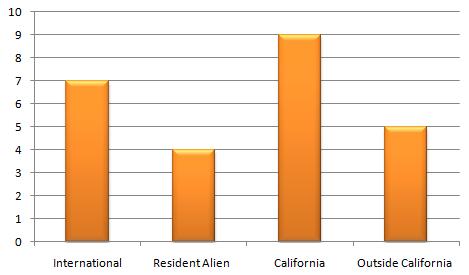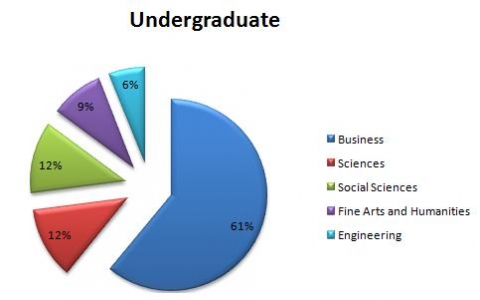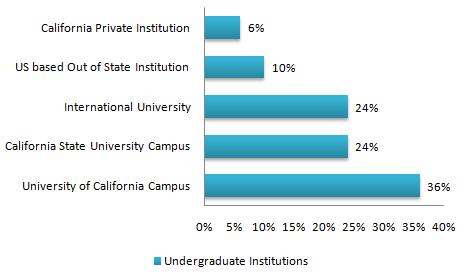 1. Mihaylo has put emphasis on Leadership and Interpersonal skills in its curriculum . Tell us how the curriculum will help MBA grads.
1. Mihaylo has put emphasis on Leadership and Interpersonal skills in its curriculum . Tell us how the curriculum will help MBA grads.
For decades, business has uniformly told MBA programs nationwide that they deliver graduates who have incredible book knowledge but poor interpersonal and soft skills. These are skills like being able to make decisions with incomplete information, how to negotiate, manage human capital, and how to communicate effectively. Study after study has told MBA programs that they had to do much more than put a class on “leadership” in the curriculum, which in some limited cases addressed the problem but mostly just gave them yet another academic experience centered on learning theories with perhaps a case study or two. We in academia tend to reject anything that is seen as a “practical” skill because that isn’t “academic” in nature.
At Mihaylo, we have been AACSB accredited for 46 years out of the total 54 years that we have been in existence and achieved dual AACSB accreditation in 1997. So we’ve literally been part of the “gold standard” of academic status for our entire existence. That means our academic viewpoint is the same as our other AACSB peer institutions. But where we differ is in our academic mission that demands our College to be a major influencer of the regional and national economy. Simply put: we are “hard wired” to work with the business community. When we were developing our Full-time MBA program, we took the core elements of what has made our MBA program successful since 1962 and amplified them. We made the commitment to not only prepare students with the in-depth knowledge base and theories but to challenge them and provide development and training in key leadership, interpersonal and soft skills.
The curriculum of the Full-time MBA is balanced with six weeks of intensive workshops, seminars, interactive sessions, and simulations in the Mihaylo Leadership Academy. Our program is fast paced – it is a 16 month program from start to finish – so we balance the Mihaylo Leadership Academy with two weeks in three out of the four semesters. But we structured it so that what is learned in the classroom doesn’t fall in conflict with what is developed outside it. We call this the “7-2-7” where students have seven weeks of class, two weeks of Mihaylo Leadership Academy sessions, and then back into class for the final seven weeks where they can apply these emergent skills with the academic theories and case studies.
But that’s just the academic structure which certainly helps our students. It helps our graduates because it puts them in those experiences, with personal coaches and feedback sessions with business executives, where they are challenged to learn and develop these skills. With unique features where they apply this learning in simulated environments they start practicing these skills before they interview or are on the job. Because we all know – once you are on the job – the time to practice is over.
2. What is the biggest misconception about Mihaylo Full-time MBA programs?
The biggest misconception is that you have to take two or more years to have a rich and rewarding full-time MBA experience. Certainly taking more time to finish something allows for a more leisurely pace which can provide learning benefits. But the longer you are off the job, you lose out in terms of earning ability and debt load hurting your overall opportunity cost calculation. Yes, a 16 month full-time MBA program is intense. Our students do have some time off between semesters, but it requires intense focus and dedication. But they are attracted to it because, especially in this economy, you can’t afford to be out of the workplace for too long. And if your knowledge and skill attainment leaves holes, your ability to make up for those is compromised.
3. What are some of the networking opportunities provided by Mihaylo?
Mihaylo has the largest alumni network in Southern California of any B-School in the world. There are over 50,000 Mihaylo alums working and living in Southern California alone – not to mention the thousands across the nation and world. Couple that with the fact that Southern California is a truly unique world economy – the second largest metro area in the US (behind the Boston to DC “region”) – with a population larger than only 59 countries, and you have an unrivaled network. Our feeling is that if you can “make it” in Southern California, then you can make it anywhere.
Since Mihaylo is the fourth largest B-school in the nation, we are able to leverage many resources that other B-schools can only dream of. Through our 15 Centers of Excellence, our alumni programming, MBA Career Center programming, and specific MBA programming, our students have hundreds of networking opportunities. Some quick examples from this spring were employer information and hiring sessions from dozens of companies (Target, Gallup, Costco, KPMG, the CIA, and Disney are some examples), recruiter breakfasts (which included companies like Warner Brothers, New York Life, Disney, Target, Bank of California, and Merrill Lynch), partnering with organizations like ACG, and dozens of speakers and networking events with executives and business professionals.
4. How is the student life in Mihaylo?
Cal State Fullerton is the third largest university in California so the campus environment is diverse and full of activity. Mihaylo is a centerpoint for the campus and our programs run throughout the day and evening making it a busy, exciting educational environment. With plenty of open space, coffee areas, private team rooms, graduate student lounges, and computer labs, students regularly use Mihaylo Hall as their headquarters. Being in Southern California and our particular institutional environment makes Mihaylo a very diverse environment.
Cal State Fullerton is recognized in the top five universities in the nation for Hispanic graduates and the world economy diversity of our region makes for a natural diversity of the student body. This adds to the dynamic nature and helps prepare our students for the world economy because they are learning next to so many people from so many different regions and nationalities. This, again, creates a more natural environment rather than something that feels forced.
5. Every school promotes its MBA program based on its Accreditations, ROI, Job prospects and Unique learning methodologies. What makes Mihaylo stand out from the competition?
The value of Mihaylo is best measured in the confluence of three factors. First we are an AACSB dually accredited institution which puts us in a category with only 8% of institutions world-wide. Along with that is our academic mission which focuses upon the application of learning and creating structures which directly impact and work with the business community. Second, our “playground” or “learning laboratory” is located in Southern California which is unrivaled from most other regions. Lastly, the truly unique “Titan Army” of our 50,000+ alums who impact the SoCal economy every day. Those three factors together make Mihaylo a truly unique and valued institution.
And we don’t stop there. Add the unique Mihaylo Leadership Academy component of our Full-time program, the 15 Centers for Excellence, and dozens of other factors that separate Mihaylo from the others.
6. Can you give our readers a demographic snapshot of the Mihaylo Full-time MBA program(latest class) ?
No of Students: 25
Average GMAT: 623
Average GPA: 3.24
Class Profile

Undergraduate Institutions
7. What are the entry criteria in terms of the number of years of experience/GMAT/GPA for Mihaylo Full-time MBA program?
Since the program is new there are not enough years to give multi-year averages for our admitted students.
For our evening program, the averages for our admitted students is a 585 GMAT and a 3.2 GPA.
The averages of our admits in the first class for the Full-time MBA is a 623 GMAT and 3.24 GPA.
We recommend that students have at least three years of work experience but we do not require it to be considered; however, work experience is a factor in the competitive admissions decisions.
8. What are the post-MBA opportunities available for Mihaylo MBA Grads?
Our graduates work in hundreds of companies in the region and throughout the world. Recent graduates have been hired in companies such as Boeing, Deloitte & Touche, Fluor, FOX Sports, Ford Motor Company, Hewlett Packard, Kaiser Permanente, KPMG, Merrill Lynch, Morgan Stanley, Nestle, Paramount Pictures, PricewaterhouseCoopers, Toshiba, US Bank, Verizon, Walt Disney Company, and Warner Brothers.
9. Apart from the Full-time MBA program, what are some of the other programs offered by Mihaylo College of Business and Economics?
Mihaylo offers the MBA in three platforms: the Full-time program, our Evening/Flex program (which is ranked in the top 125 programs nationwide by US News & World Report), and our MBA for Working Professionals (FEMBA). Additionally, Mihaylo offers a Master’s of Accountancy, Master’s of Taxation, Master’s of Economics, Master’s of Information Systems, and Master’s of Information Technology (online program).
About Van Muse Van Muse is the Director of MBA Programs for the Mihaylo College of Business and Economics at California State University, Fullerton. He oversees all functions and operations for MBA programs across the three main platforms: Full-time, Evening/Flex, and MBA for Working Professionals; which includes directing recruitment, admissions, academic advising, and career development operations as well as assisting the College in the management in six other graduate programs. Van’s areas of expertise are in academic administration, recruitment and institutional marketing, enrollment management, and program and curriculum development.
Van Muse is the Director of MBA Programs for the Mihaylo College of Business and Economics at California State University, Fullerton. He oversees all functions and operations for MBA programs across the three main platforms: Full-time, Evening/Flex, and MBA for Working Professionals; which includes directing recruitment, admissions, academic advising, and career development operations as well as assisting the College in the management in six other graduate programs. Van’s areas of expertise are in academic administration, recruitment and institutional marketing, enrollment management, and program and curriculum development.
Prior to working at Mihaylo, Van was the Dean of Academic Affairs for The Art Institute of California, Hollywood and the Dean of Instruction and the Director of the Center for New Media for Kalamazoo Valley Community College (Michigan). Van completed his Ed.D in Higher Education Administration in 1999 from Auburn University (Alabama), his Master’s in English in 1995 from Auburn University, and his Bachelor’s in English in 1991 from Ohio University.